HRM's Role in Enhancing Organizational Performance: A Deep Dive
VerifiedAdded on 2022/10/18
|10
|3121
|169
Essay
AI Summary
This essay delves into the crucial relationship between Human Resource Management (HRM) and organizational performance. It explores how HRM practices, including compensation, rewards, and recognition, influence employee motivation and contribute to a positive work environment. The essay discusses the importance of aligning HRM with Maslow's hierarchy of needs to address employees' physiological, safety, social, esteem, and self-actualization needs. Furthermore, it examines strategic HRM, its alignment with organizational goals, and the implementation of models like the 5P model. The paper also presents arguments on the effectiveness of strategic HRM, highlighting the impact of training and development, and ultimately emphasizes the essential role of HRM in enhancing organizational performance and achieving long-term success. The essay also focuses on the role of HR in motivating employees and the impact of strategic HRM on employee performance. The essay concludes by emphasizing the significance of HRM in achieving organizational success.
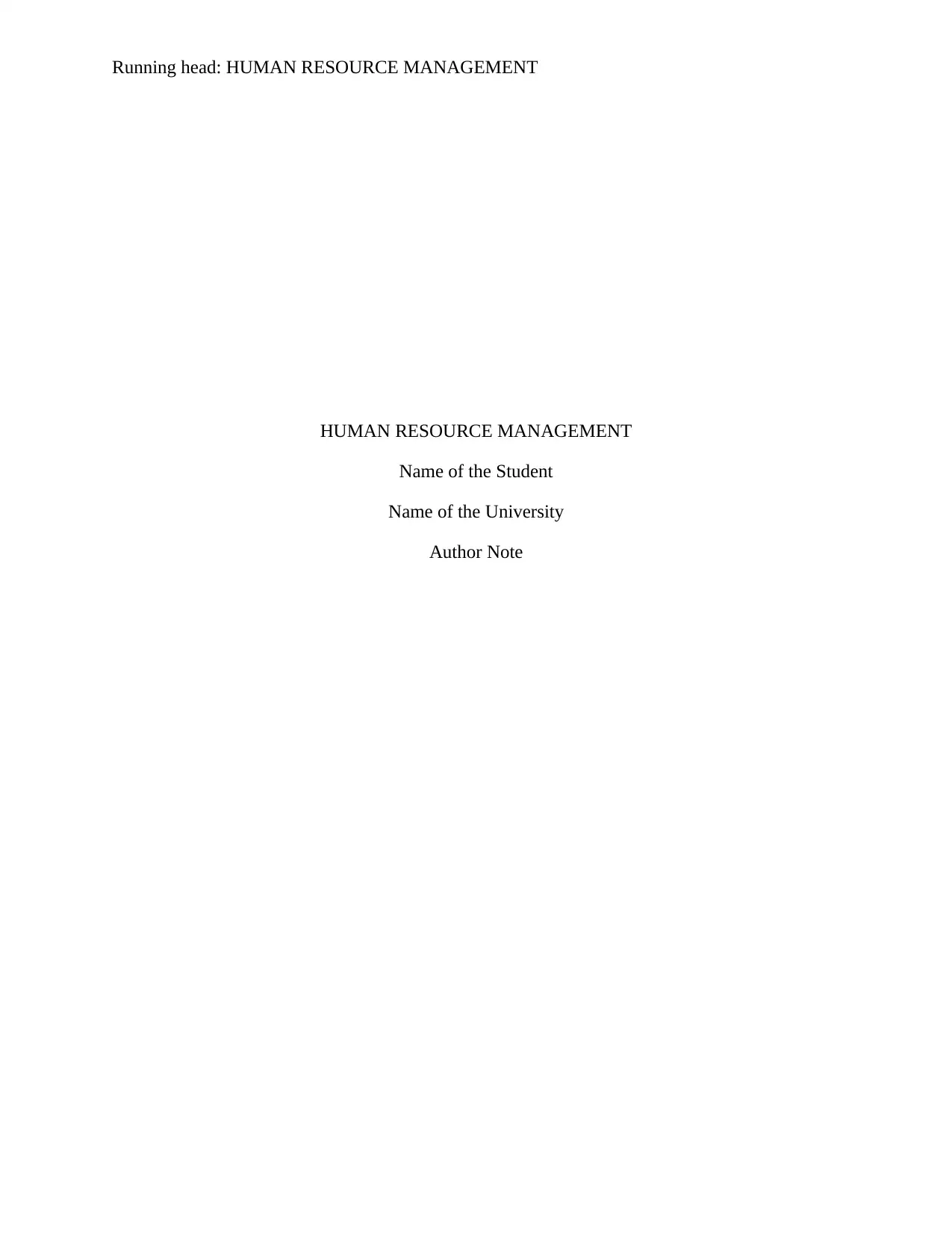
Running head: HUMAN RESOURCE MANAGEMENT
HUMAN RESOURCE MANAGEMENT
Name of the Student
Name of the University
Author Note
HUMAN RESOURCE MANAGEMENT
Name of the Student
Name of the University
Author Note
Paraphrase This Document
Need a fresh take? Get an instant paraphrase of this document with our AI Paraphraser
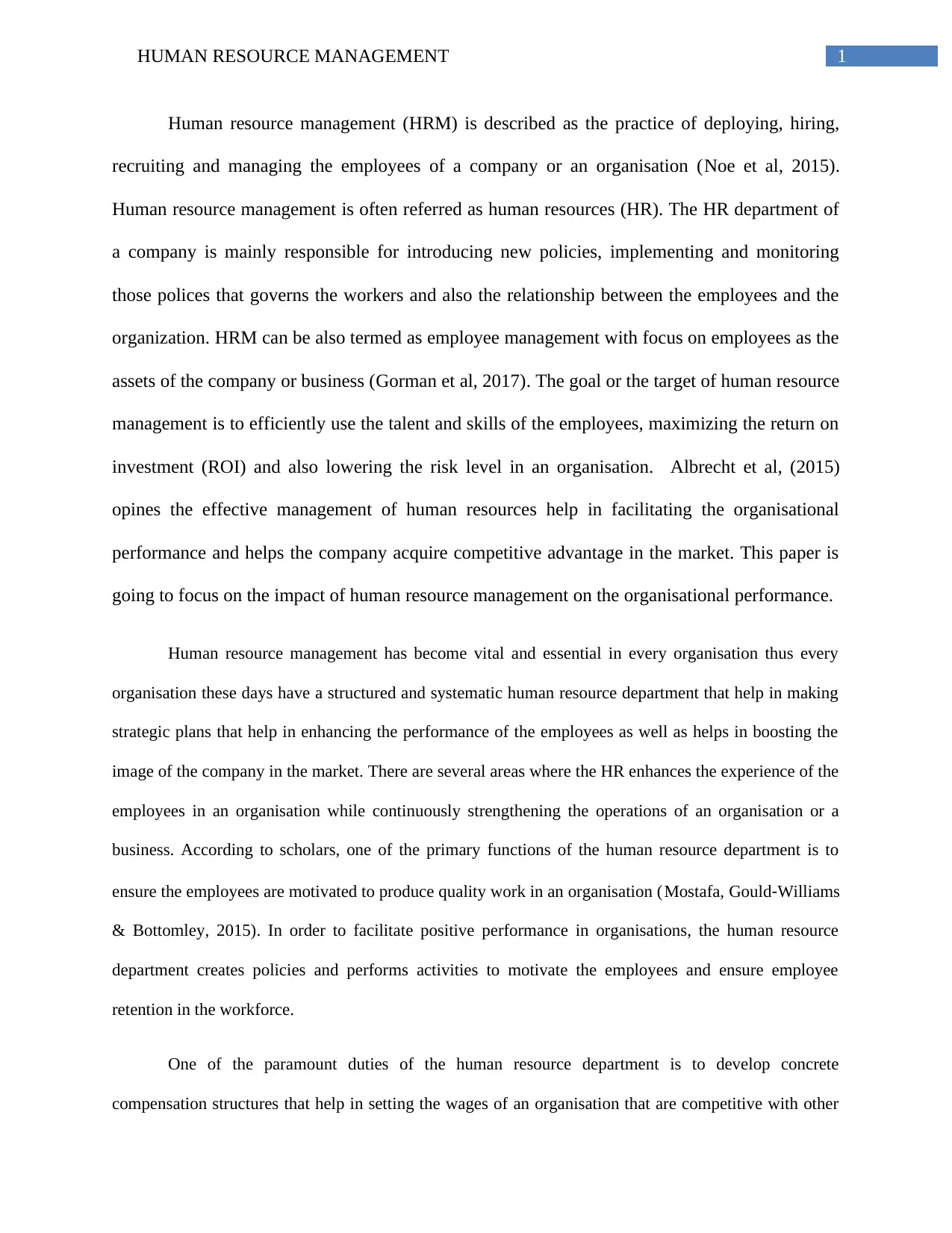
1HUMAN RESOURCE MANAGEMENT
Human resource management (HRM) is described as the practice of deploying, hiring,
recruiting and managing the employees of a company or an organisation (Noe et al, 2015).
Human resource management is often referred as human resources (HR). The HR department of
a company is mainly responsible for introducing new policies, implementing and monitoring
those polices that governs the workers and also the relationship between the employees and the
organization. HRM can be also termed as employee management with focus on employees as the
assets of the company or business (Gorman et al, 2017). The goal or the target of human resource
management is to efficiently use the talent and skills of the employees, maximizing the return on
investment (ROI) and also lowering the risk level in an organisation. Albrecht et al, (2015)
opines the effective management of human resources help in facilitating the organisational
performance and helps the company acquire competitive advantage in the market. This paper is
going to focus on the impact of human resource management on the organisational performance.
Human resource management has become vital and essential in every organisation thus every
organisation these days have a structured and systematic human resource department that help in making
strategic plans that help in enhancing the performance of the employees as well as helps in boosting the
image of the company in the market. There are several areas where the HR enhances the experience of the
employees in an organisation while continuously strengthening the operations of an organisation or a
business. According to scholars, one of the primary functions of the human resource department is to
ensure the employees are motivated to produce quality work in an organisation (Mostafa, Gould‐Williams
& Bottomley, 2015). In order to facilitate positive performance in organisations, the human resource
department creates policies and performs activities to motivate the employees and ensure employee
retention in the workforce.
One of the paramount duties of the human resource department is to develop concrete
compensation structures that help in setting the wages of an organisation that are competitive with other
Human resource management (HRM) is described as the practice of deploying, hiring,
recruiting and managing the employees of a company or an organisation (Noe et al, 2015).
Human resource management is often referred as human resources (HR). The HR department of
a company is mainly responsible for introducing new policies, implementing and monitoring
those polices that governs the workers and also the relationship between the employees and the
organization. HRM can be also termed as employee management with focus on employees as the
assets of the company or business (Gorman et al, 2017). The goal or the target of human resource
management is to efficiently use the talent and skills of the employees, maximizing the return on
investment (ROI) and also lowering the risk level in an organisation. Albrecht et al, (2015)
opines the effective management of human resources help in facilitating the organisational
performance and helps the company acquire competitive advantage in the market. This paper is
going to focus on the impact of human resource management on the organisational performance.
Human resource management has become vital and essential in every organisation thus every
organisation these days have a structured and systematic human resource department that help in making
strategic plans that help in enhancing the performance of the employees as well as helps in boosting the
image of the company in the market. There are several areas where the HR enhances the experience of the
employees in an organisation while continuously strengthening the operations of an organisation or a
business. According to scholars, one of the primary functions of the human resource department is to
ensure the employees are motivated to produce quality work in an organisation (Mostafa, Gould‐Williams
& Bottomley, 2015). In order to facilitate positive performance in organisations, the human resource
department creates policies and performs activities to motivate the employees and ensure employee
retention in the workforce.
One of the paramount duties of the human resource department is to develop concrete
compensation structures that help in setting the wages of an organisation that are competitive with other
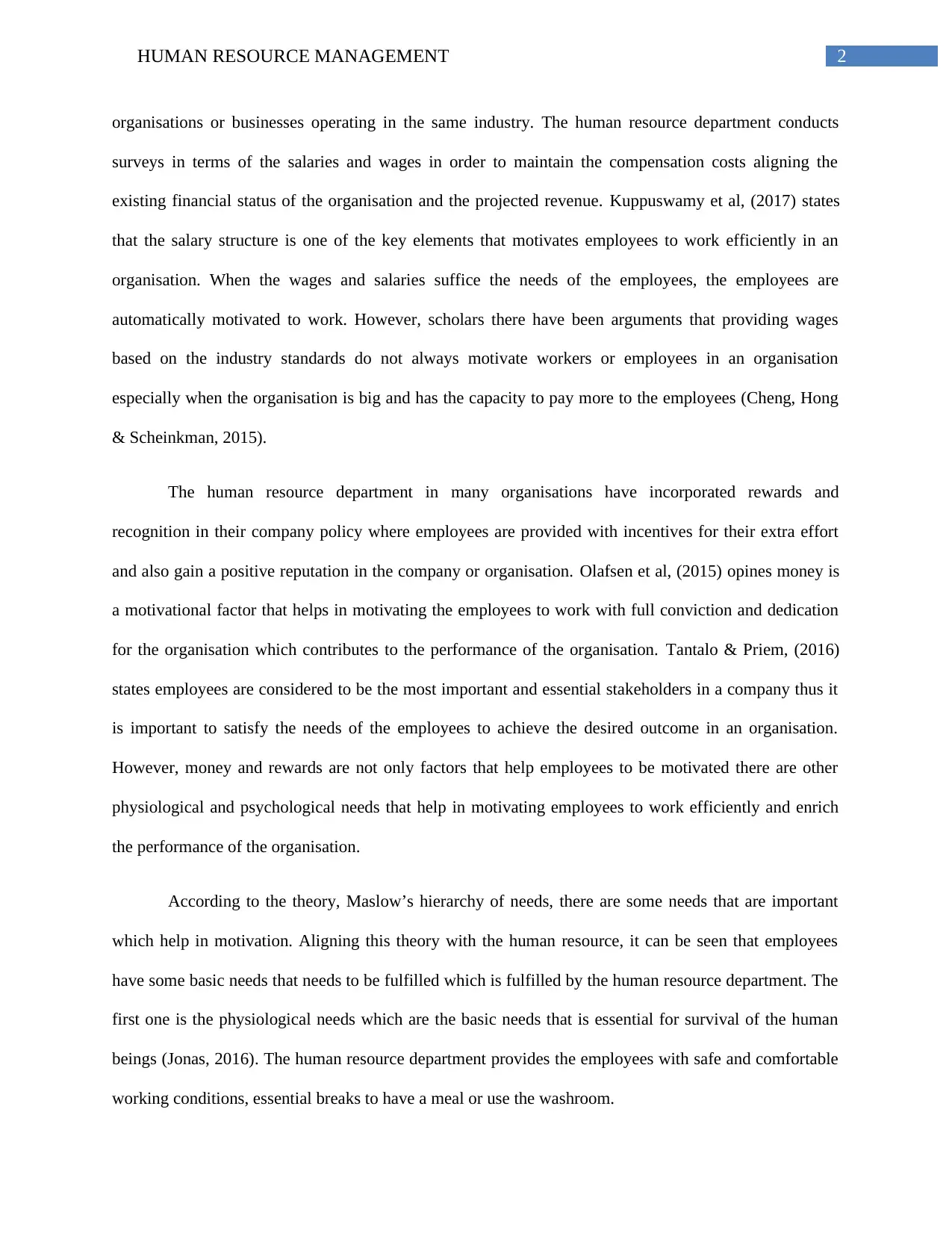
2HUMAN RESOURCE MANAGEMENT
organisations or businesses operating in the same industry. The human resource department conducts
surveys in terms of the salaries and wages in order to maintain the compensation costs aligning the
existing financial status of the organisation and the projected revenue. Kuppuswamy et al, (2017) states
that the salary structure is one of the key elements that motivates employees to work efficiently in an
organisation. When the wages and salaries suffice the needs of the employees, the employees are
automatically motivated to work. However, scholars there have been arguments that providing wages
based on the industry standards do not always motivate workers or employees in an organisation
especially when the organisation is big and has the capacity to pay more to the employees (Cheng, Hong
& Scheinkman, 2015).
The human resource department in many organisations have incorporated rewards and
recognition in their company policy where employees are provided with incentives for their extra effort
and also gain a positive reputation in the company or organisation. Olafsen et al, (2015) opines money is
a motivational factor that helps in motivating the employees to work with full conviction and dedication
for the organisation which contributes to the performance of the organisation. Tantalo & Priem, (2016)
states employees are considered to be the most important and essential stakeholders in a company thus it
is important to satisfy the needs of the employees to achieve the desired outcome in an organisation.
However, money and rewards are not only factors that help employees to be motivated there are other
physiological and psychological needs that help in motivating employees to work efficiently and enrich
the performance of the organisation.
According to the theory, Maslow’s hierarchy of needs, there are some needs that are important
which help in motivation. Aligning this theory with the human resource, it can be seen that employees
have some basic needs that needs to be fulfilled which is fulfilled by the human resource department. The
first one is the physiological needs which are the basic needs that is essential for survival of the human
beings (Jonas, 2016). The human resource department provides the employees with safe and comfortable
working conditions, essential breaks to have a meal or use the washroom.
organisations or businesses operating in the same industry. The human resource department conducts
surveys in terms of the salaries and wages in order to maintain the compensation costs aligning the
existing financial status of the organisation and the projected revenue. Kuppuswamy et al, (2017) states
that the salary structure is one of the key elements that motivates employees to work efficiently in an
organisation. When the wages and salaries suffice the needs of the employees, the employees are
automatically motivated to work. However, scholars there have been arguments that providing wages
based on the industry standards do not always motivate workers or employees in an organisation
especially when the organisation is big and has the capacity to pay more to the employees (Cheng, Hong
& Scheinkman, 2015).
The human resource department in many organisations have incorporated rewards and
recognition in their company policy where employees are provided with incentives for their extra effort
and also gain a positive reputation in the company or organisation. Olafsen et al, (2015) opines money is
a motivational factor that helps in motivating the employees to work with full conviction and dedication
for the organisation which contributes to the performance of the organisation. Tantalo & Priem, (2016)
states employees are considered to be the most important and essential stakeholders in a company thus it
is important to satisfy the needs of the employees to achieve the desired outcome in an organisation.
However, money and rewards are not only factors that help employees to be motivated there are other
physiological and psychological needs that help in motivating employees to work efficiently and enrich
the performance of the organisation.
According to the theory, Maslow’s hierarchy of needs, there are some needs that are important
which help in motivation. Aligning this theory with the human resource, it can be seen that employees
have some basic needs that needs to be fulfilled which is fulfilled by the human resource department. The
first one is the physiological needs which are the basic needs that is essential for survival of the human
beings (Jonas, 2016). The human resource department provides the employees with safe and comfortable
working conditions, essential breaks to have a meal or use the washroom.
⊘ This is a preview!⊘
Do you want full access?
Subscribe today to unlock all pages.

Trusted by 1+ million students worldwide
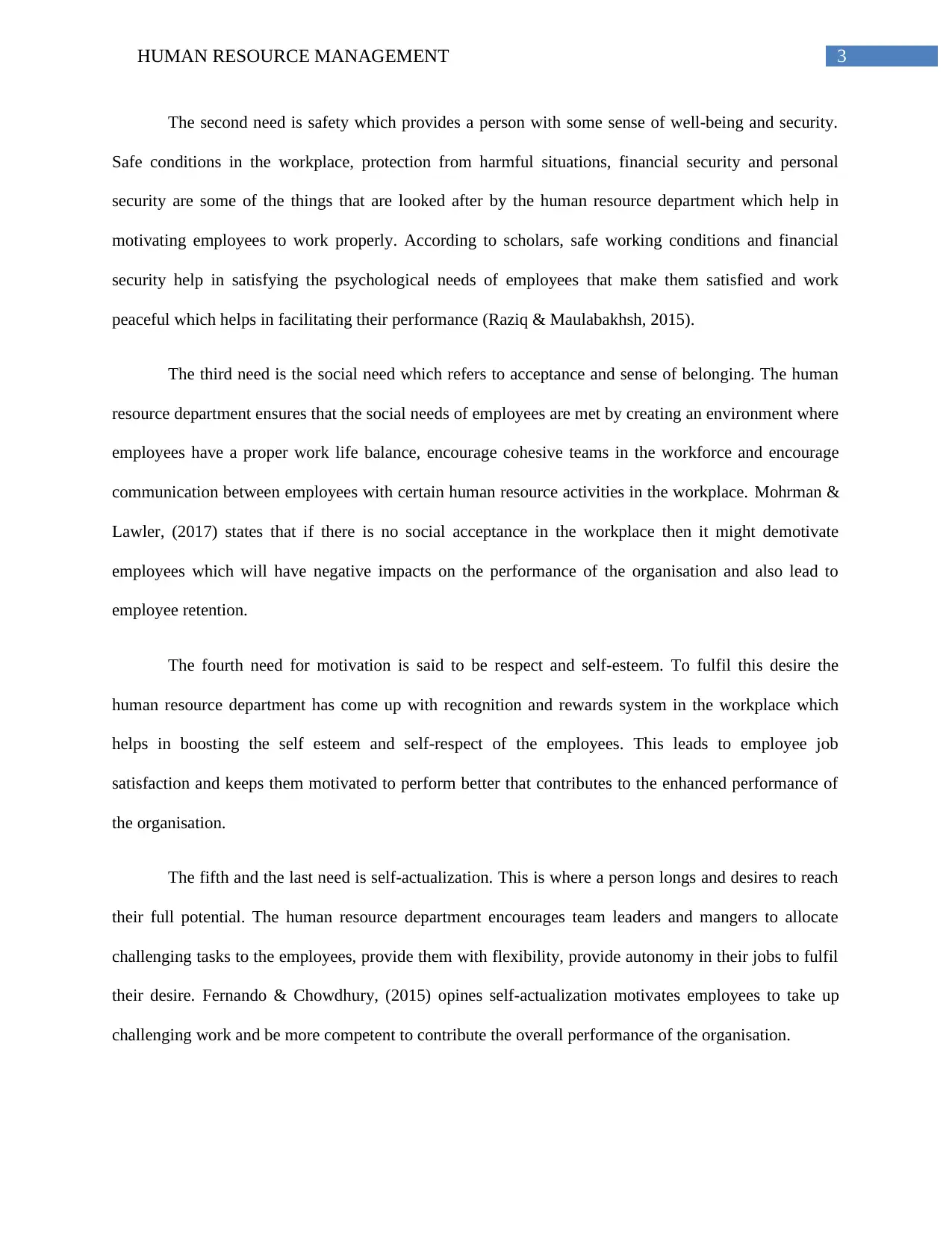
3HUMAN RESOURCE MANAGEMENT
The second need is safety which provides a person with some sense of well-being and security.
Safe conditions in the workplace, protection from harmful situations, financial security and personal
security are some of the things that are looked after by the human resource department which help in
motivating employees to work properly. According to scholars, safe working conditions and financial
security help in satisfying the psychological needs of employees that make them satisfied and work
peaceful which helps in facilitating their performance (Raziq & Maulabakhsh, 2015).
The third need is the social need which refers to acceptance and sense of belonging. The human
resource department ensures that the social needs of employees are met by creating an environment where
employees have a proper work life balance, encourage cohesive teams in the workforce and encourage
communication between employees with certain human resource activities in the workplace. Mohrman &
Lawler, (2017) states that if there is no social acceptance in the workplace then it might demotivate
employees which will have negative impacts on the performance of the organisation and also lead to
employee retention.
The fourth need for motivation is said to be respect and self-esteem. To fulfil this desire the
human resource department has come up with recognition and rewards system in the workplace which
helps in boosting the self esteem and self-respect of the employees. This leads to employee job
satisfaction and keeps them motivated to perform better that contributes to the enhanced performance of
the organisation.
The fifth and the last need is self-actualization. This is where a person longs and desires to reach
their full potential. The human resource department encourages team leaders and mangers to allocate
challenging tasks to the employees, provide them with flexibility, provide autonomy in their jobs to fulfil
their desire. Fernando & Chowdhury, (2015) opines self-actualization motivates employees to take up
challenging work and be more competent to contribute the overall performance of the organisation.
The second need is safety which provides a person with some sense of well-being and security.
Safe conditions in the workplace, protection from harmful situations, financial security and personal
security are some of the things that are looked after by the human resource department which help in
motivating employees to work properly. According to scholars, safe working conditions and financial
security help in satisfying the psychological needs of employees that make them satisfied and work
peaceful which helps in facilitating their performance (Raziq & Maulabakhsh, 2015).
The third need is the social need which refers to acceptance and sense of belonging. The human
resource department ensures that the social needs of employees are met by creating an environment where
employees have a proper work life balance, encourage cohesive teams in the workforce and encourage
communication between employees with certain human resource activities in the workplace. Mohrman &
Lawler, (2017) states that if there is no social acceptance in the workplace then it might demotivate
employees which will have negative impacts on the performance of the organisation and also lead to
employee retention.
The fourth need for motivation is said to be respect and self-esteem. To fulfil this desire the
human resource department has come up with recognition and rewards system in the workplace which
helps in boosting the self esteem and self-respect of the employees. This leads to employee job
satisfaction and keeps them motivated to perform better that contributes to the enhanced performance of
the organisation.
The fifth and the last need is self-actualization. This is where a person longs and desires to reach
their full potential. The human resource department encourages team leaders and mangers to allocate
challenging tasks to the employees, provide them with flexibility, provide autonomy in their jobs to fulfil
their desire. Fernando & Chowdhury, (2015) opines self-actualization motivates employees to take up
challenging work and be more competent to contribute the overall performance of the organisation.
Paraphrase This Document
Need a fresh take? Get an instant paraphrase of this document with our AI Paraphraser
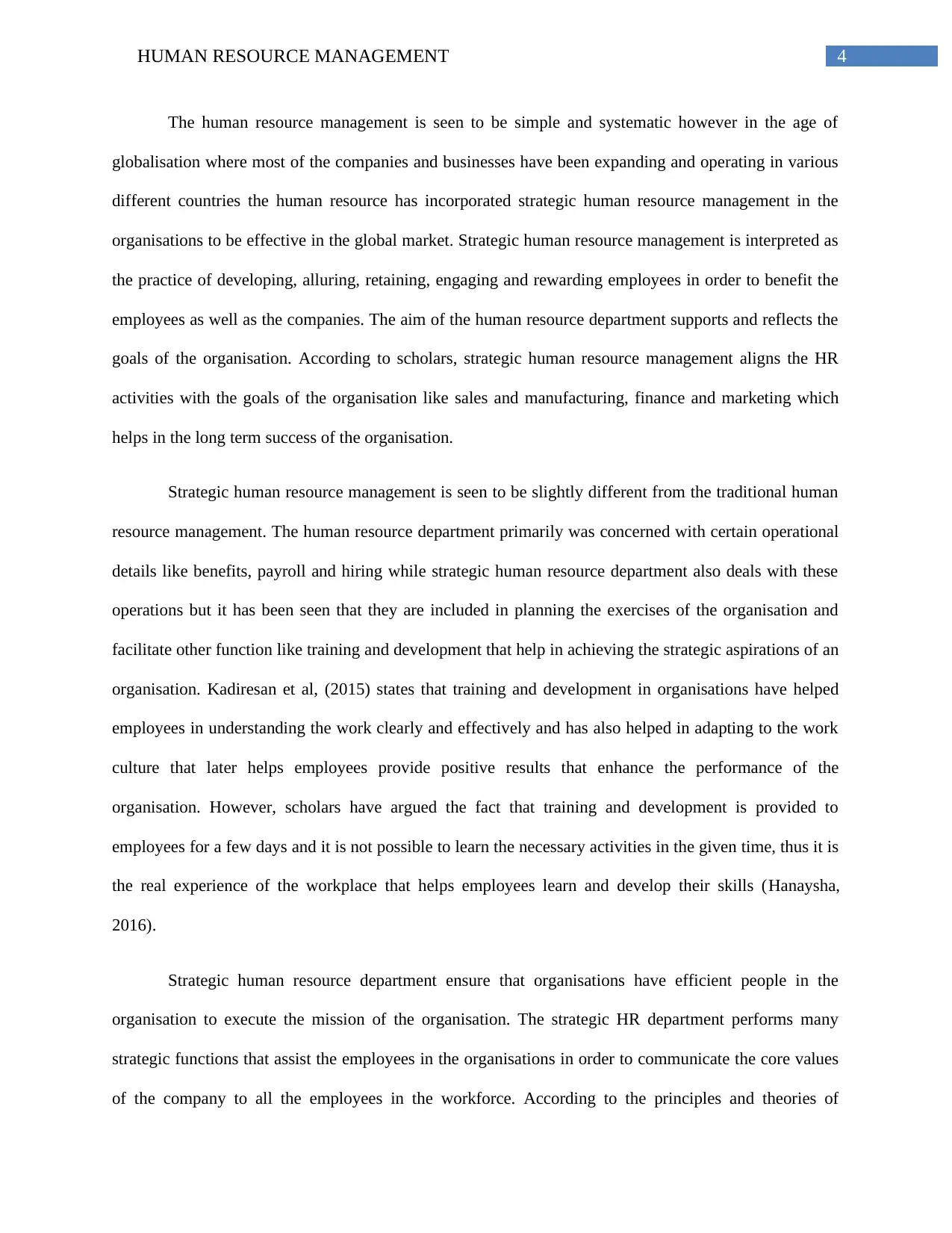
4HUMAN RESOURCE MANAGEMENT
The human resource management is seen to be simple and systematic however in the age of
globalisation where most of the companies and businesses have been expanding and operating in various
different countries the human resource has incorporated strategic human resource management in the
organisations to be effective in the global market. Strategic human resource management is interpreted as
the practice of developing, alluring, retaining, engaging and rewarding employees in order to benefit the
employees as well as the companies. The aim of the human resource department supports and reflects the
goals of the organisation. According to scholars, strategic human resource management aligns the HR
activities with the goals of the organisation like sales and manufacturing, finance and marketing which
helps in the long term success of the organisation.
Strategic human resource management is seen to be slightly different from the traditional human
resource management. The human resource department primarily was concerned with certain operational
details like benefits, payroll and hiring while strategic human resource department also deals with these
operations but it has been seen that they are included in planning the exercises of the organisation and
facilitate other function like training and development that help in achieving the strategic aspirations of an
organisation. Kadiresan et al, (2015) states that training and development in organisations have helped
employees in understanding the work clearly and effectively and has also helped in adapting to the work
culture that later helps employees provide positive results that enhance the performance of the
organisation. However, scholars have argued the fact that training and development is provided to
employees for a few days and it is not possible to learn the necessary activities in the given time, thus it is
the real experience of the workplace that helps employees learn and develop their skills (Hanaysha,
2016).
Strategic human resource department ensure that organisations have efficient people in the
organisation to execute the mission of the organisation. The strategic HR department performs many
strategic functions that assist the employees in the organisations in order to communicate the core values
of the company to all the employees in the workforce. According to the principles and theories of
The human resource management is seen to be simple and systematic however in the age of
globalisation where most of the companies and businesses have been expanding and operating in various
different countries the human resource has incorporated strategic human resource management in the
organisations to be effective in the global market. Strategic human resource management is interpreted as
the practice of developing, alluring, retaining, engaging and rewarding employees in order to benefit the
employees as well as the companies. The aim of the human resource department supports and reflects the
goals of the organisation. According to scholars, strategic human resource management aligns the HR
activities with the goals of the organisation like sales and manufacturing, finance and marketing which
helps in the long term success of the organisation.
Strategic human resource management is seen to be slightly different from the traditional human
resource management. The human resource department primarily was concerned with certain operational
details like benefits, payroll and hiring while strategic human resource department also deals with these
operations but it has been seen that they are included in planning the exercises of the organisation and
facilitate other function like training and development that help in achieving the strategic aspirations of an
organisation. Kadiresan et al, (2015) states that training and development in organisations have helped
employees in understanding the work clearly and effectively and has also helped in adapting to the work
culture that later helps employees provide positive results that enhance the performance of the
organisation. However, scholars have argued the fact that training and development is provided to
employees for a few days and it is not possible to learn the necessary activities in the given time, thus it is
the real experience of the workplace that helps employees learn and develop their skills (Hanaysha,
2016).
Strategic human resource department ensure that organisations have efficient people in the
organisation to execute the mission of the organisation. The strategic HR department performs many
strategic functions that assist the employees in the organisations in order to communicate the core values
of the company to all the employees in the workforce. According to the principles and theories of
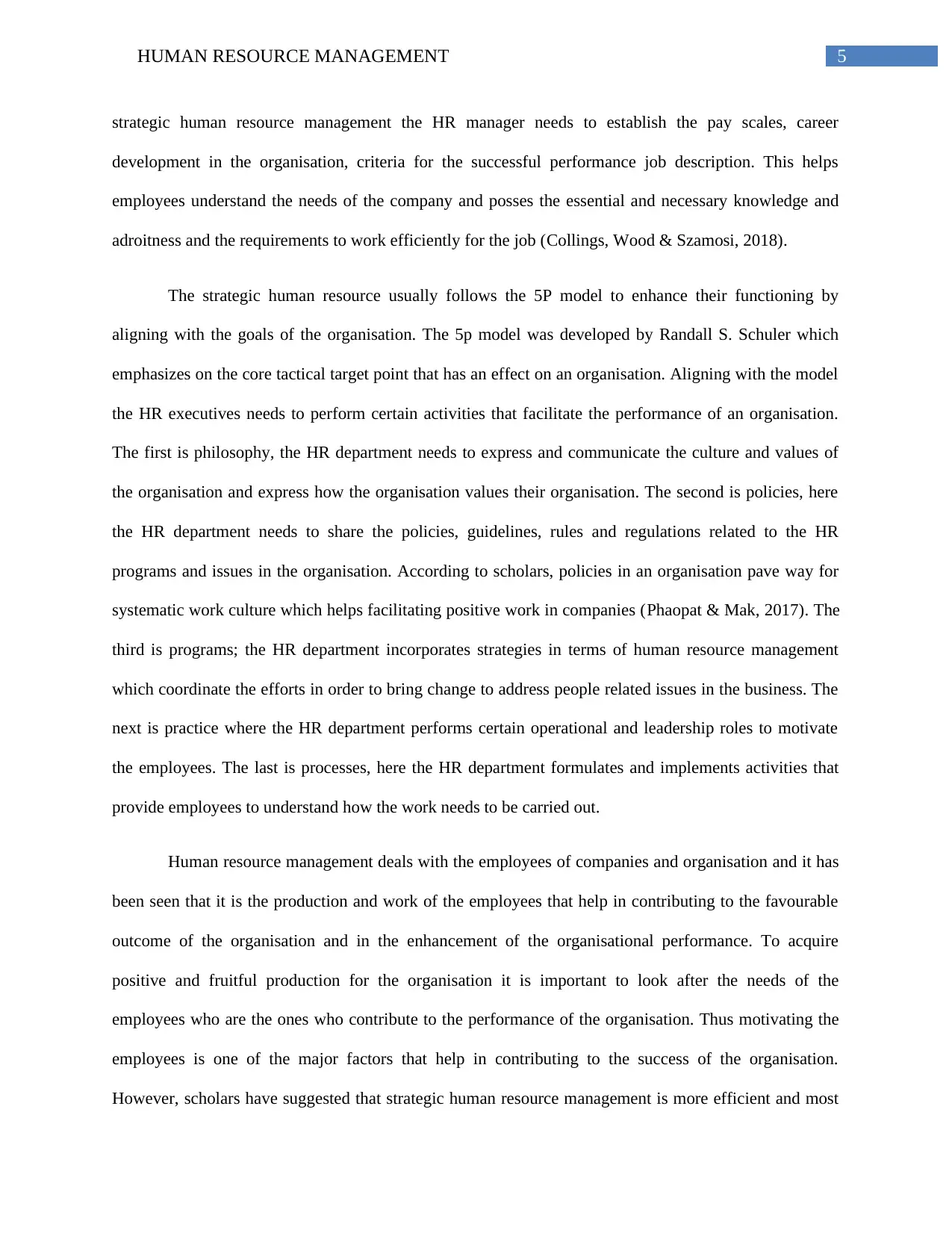
5HUMAN RESOURCE MANAGEMENT
strategic human resource management the HR manager needs to establish the pay scales, career
development in the organisation, criteria for the successful performance job description. This helps
employees understand the needs of the company and posses the essential and necessary knowledge and
adroitness and the requirements to work efficiently for the job (Collings, Wood & Szamosi, 2018).
The strategic human resource usually follows the 5P model to enhance their functioning by
aligning with the goals of the organisation. The 5p model was developed by Randall S. Schuler which
emphasizes on the core tactical target point that has an effect on an organisation. Aligning with the model
the HR executives needs to perform certain activities that facilitate the performance of an organisation.
The first is philosophy, the HR department needs to express and communicate the culture and values of
the organisation and express how the organisation values their organisation. The second is policies, here
the HR department needs to share the policies, guidelines, rules and regulations related to the HR
programs and issues in the organisation. According to scholars, policies in an organisation pave way for
systematic work culture which helps facilitating positive work in companies (Phaopat & Mak, 2017). The
third is programs; the HR department incorporates strategies in terms of human resource management
which coordinate the efforts in order to bring change to address people related issues in the business. The
next is practice where the HR department performs certain operational and leadership roles to motivate
the employees. The last is processes, here the HR department formulates and implements activities that
provide employees to understand how the work needs to be carried out.
Human resource management deals with the employees of companies and organisation and it has
been seen that it is the production and work of the employees that help in contributing to the favourable
outcome of the organisation and in the enhancement of the organisational performance. To acquire
positive and fruitful production for the organisation it is important to look after the needs of the
employees who are the ones who contribute to the performance of the organisation. Thus motivating the
employees is one of the major factors that help in contributing to the success of the organisation.
However, scholars have suggested that strategic human resource management is more efficient and most
strategic human resource management the HR manager needs to establish the pay scales, career
development in the organisation, criteria for the successful performance job description. This helps
employees understand the needs of the company and posses the essential and necessary knowledge and
adroitness and the requirements to work efficiently for the job (Collings, Wood & Szamosi, 2018).
The strategic human resource usually follows the 5P model to enhance their functioning by
aligning with the goals of the organisation. The 5p model was developed by Randall S. Schuler which
emphasizes on the core tactical target point that has an effect on an organisation. Aligning with the model
the HR executives needs to perform certain activities that facilitate the performance of an organisation.
The first is philosophy, the HR department needs to express and communicate the culture and values of
the organisation and express how the organisation values their organisation. The second is policies, here
the HR department needs to share the policies, guidelines, rules and regulations related to the HR
programs and issues in the organisation. According to scholars, policies in an organisation pave way for
systematic work culture which helps facilitating positive work in companies (Phaopat & Mak, 2017). The
third is programs; the HR department incorporates strategies in terms of human resource management
which coordinate the efforts in order to bring change to address people related issues in the business. The
next is practice where the HR department performs certain operational and leadership roles to motivate
the employees. The last is processes, here the HR department formulates and implements activities that
provide employees to understand how the work needs to be carried out.
Human resource management deals with the employees of companies and organisation and it has
been seen that it is the production and work of the employees that help in contributing to the favourable
outcome of the organisation and in the enhancement of the organisational performance. To acquire
positive and fruitful production for the organisation it is important to look after the needs of the
employees who are the ones who contribute to the performance of the organisation. Thus motivating the
employees is one of the major factors that help in contributing to the success of the organisation.
However, scholars have suggested that strategic human resource management is more efficient and most
⊘ This is a preview!⊘
Do you want full access?
Subscribe today to unlock all pages.

Trusted by 1+ million students worldwide
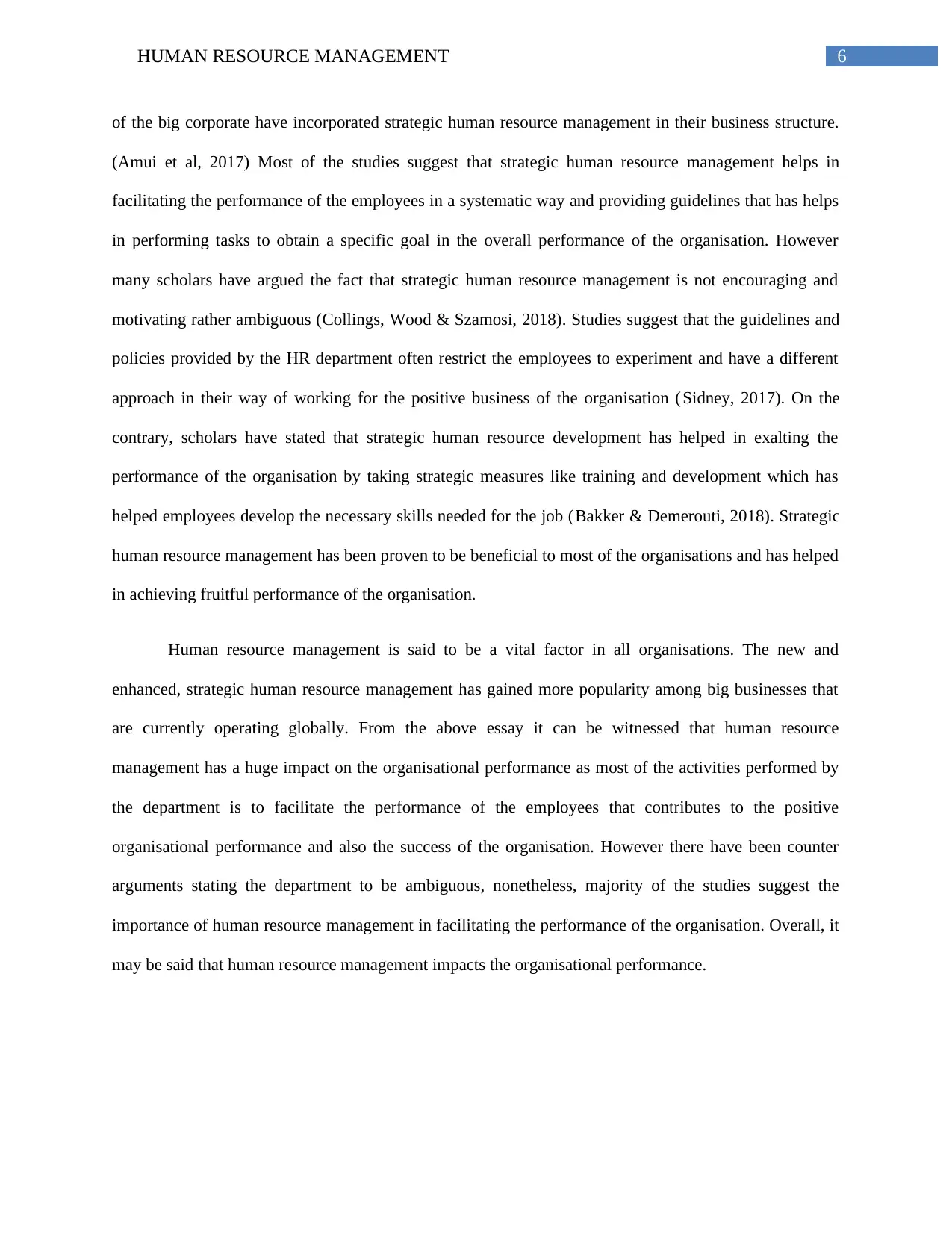
6HUMAN RESOURCE MANAGEMENT
of the big corporate have incorporated strategic human resource management in their business structure.
(Amui et al, 2017) Most of the studies suggest that strategic human resource management helps in
facilitating the performance of the employees in a systematic way and providing guidelines that has helps
in performing tasks to obtain a specific goal in the overall performance of the organisation. However
many scholars have argued the fact that strategic human resource management is not encouraging and
motivating rather ambiguous (Collings, Wood & Szamosi, 2018). Studies suggest that the guidelines and
policies provided by the HR department often restrict the employees to experiment and have a different
approach in their way of working for the positive business of the organisation ( Sidney, 2017). On the
contrary, scholars have stated that strategic human resource development has helped in exalting the
performance of the organisation by taking strategic measures like training and development which has
helped employees develop the necessary skills needed for the job (Bakker & Demerouti, 2018). Strategic
human resource management has been proven to be beneficial to most of the organisations and has helped
in achieving fruitful performance of the organisation.
Human resource management is said to be a vital factor in all organisations. The new and
enhanced, strategic human resource management has gained more popularity among big businesses that
are currently operating globally. From the above essay it can be witnessed that human resource
management has a huge impact on the organisational performance as most of the activities performed by
the department is to facilitate the performance of the employees that contributes to the positive
organisational performance and also the success of the organisation. However there have been counter
arguments stating the department to be ambiguous, nonetheless, majority of the studies suggest the
importance of human resource management in facilitating the performance of the organisation. Overall, it
may be said that human resource management impacts the organisational performance.
of the big corporate have incorporated strategic human resource management in their business structure.
(Amui et al, 2017) Most of the studies suggest that strategic human resource management helps in
facilitating the performance of the employees in a systematic way and providing guidelines that has helps
in performing tasks to obtain a specific goal in the overall performance of the organisation. However
many scholars have argued the fact that strategic human resource management is not encouraging and
motivating rather ambiguous (Collings, Wood & Szamosi, 2018). Studies suggest that the guidelines and
policies provided by the HR department often restrict the employees to experiment and have a different
approach in their way of working for the positive business of the organisation ( Sidney, 2017). On the
contrary, scholars have stated that strategic human resource development has helped in exalting the
performance of the organisation by taking strategic measures like training and development which has
helped employees develop the necessary skills needed for the job (Bakker & Demerouti, 2018). Strategic
human resource management has been proven to be beneficial to most of the organisations and has helped
in achieving fruitful performance of the organisation.
Human resource management is said to be a vital factor in all organisations. The new and
enhanced, strategic human resource management has gained more popularity among big businesses that
are currently operating globally. From the above essay it can be witnessed that human resource
management has a huge impact on the organisational performance as most of the activities performed by
the department is to facilitate the performance of the employees that contributes to the positive
organisational performance and also the success of the organisation. However there have been counter
arguments stating the department to be ambiguous, nonetheless, majority of the studies suggest the
importance of human resource management in facilitating the performance of the organisation. Overall, it
may be said that human resource management impacts the organisational performance.
Paraphrase This Document
Need a fresh take? Get an instant paraphrase of this document with our AI Paraphraser
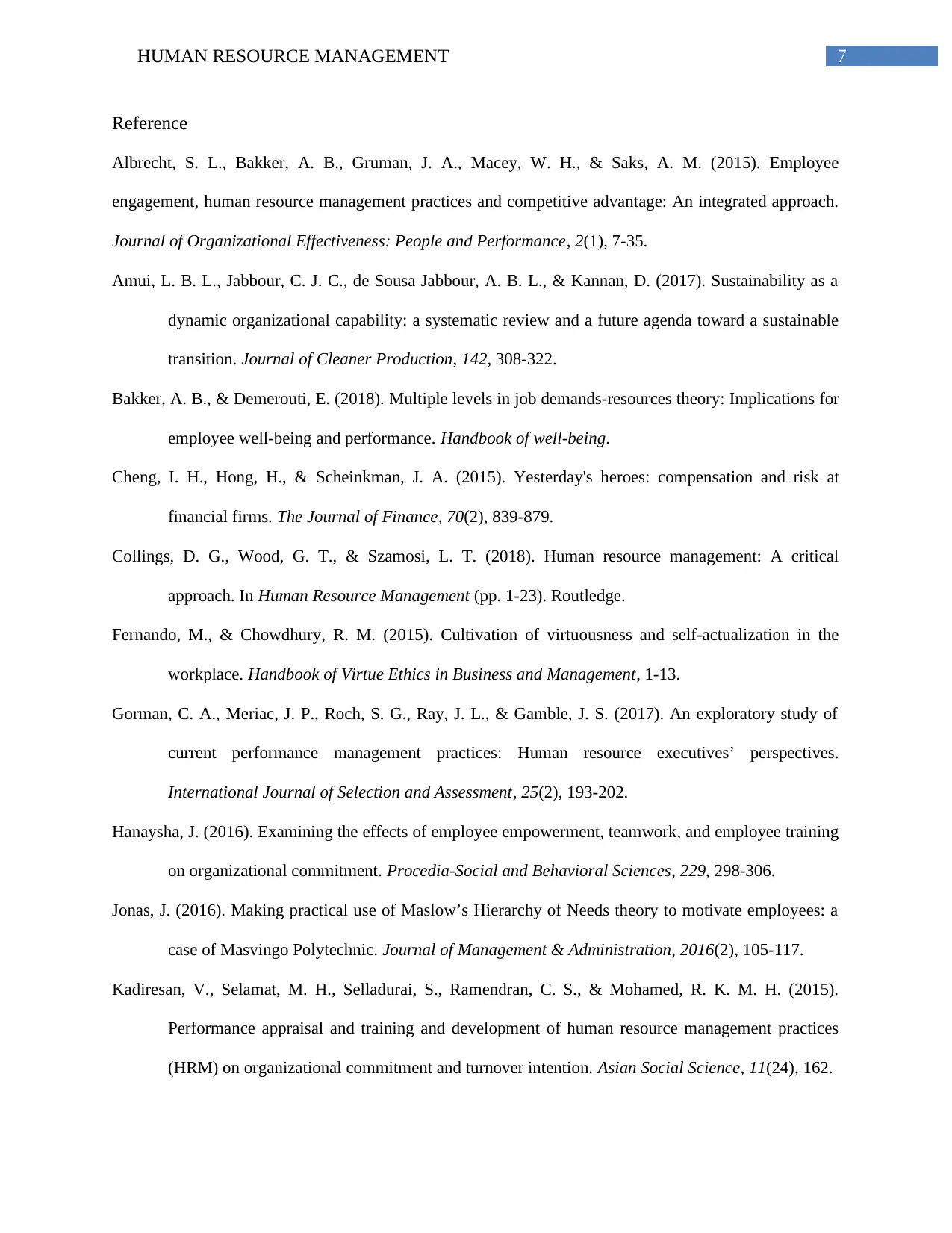
7HUMAN RESOURCE MANAGEMENT
Reference
Albrecht, S. L., Bakker, A. B., Gruman, J. A., Macey, W. H., & Saks, A. M. (2015). Employee
engagement, human resource management practices and competitive advantage: An integrated approach.
Journal of Organizational Effectiveness: People and Performance, 2(1), 7-35.
Amui, L. B. L., Jabbour, C. J. C., de Sousa Jabbour, A. B. L., & Kannan, D. (2017). Sustainability as a
dynamic organizational capability: a systematic review and a future agenda toward a sustainable
transition. Journal of Cleaner Production, 142, 308-322.
Bakker, A. B., & Demerouti, E. (2018). Multiple levels in job demands-resources theory: Implications for
employee well-being and performance. Handbook of well-being.
Cheng, I. H., Hong, H., & Scheinkman, J. A. (2015). Yesterday's heroes: compensation and risk at
financial firms. The Journal of Finance, 70(2), 839-879.
Collings, D. G., Wood, G. T., & Szamosi, L. T. (2018). Human resource management: A critical
approach. In Human Resource Management (pp. 1-23). Routledge.
Fernando, M., & Chowdhury, R. M. (2015). Cultivation of virtuousness and self-actualization in the
workplace. Handbook of Virtue Ethics in Business and Management, 1-13.
Gorman, C. A., Meriac, J. P., Roch, S. G., Ray, J. L., & Gamble, J. S. (2017). An exploratory study of
current performance management practices: Human resource executives’ perspectives.
International Journal of Selection and Assessment, 25(2), 193-202.
Hanaysha, J. (2016). Examining the effects of employee empowerment, teamwork, and employee training
on organizational commitment. Procedia-Social and Behavioral Sciences, 229, 298-306.
Jonas, J. (2016). Making practical use of Maslow’s Hierarchy of Needs theory to motivate employees: a
case of Masvingo Polytechnic. Journal of Management & Administration, 2016(2), 105-117.
Kadiresan, V., Selamat, M. H., Selladurai, S., Ramendran, C. S., & Mohamed, R. K. M. H. (2015).
Performance appraisal and training and development of human resource management practices
(HRM) on organizational commitment and turnover intention. Asian Social Science, 11(24), 162.
Reference
Albrecht, S. L., Bakker, A. B., Gruman, J. A., Macey, W. H., & Saks, A. M. (2015). Employee
engagement, human resource management practices and competitive advantage: An integrated approach.
Journal of Organizational Effectiveness: People and Performance, 2(1), 7-35.
Amui, L. B. L., Jabbour, C. J. C., de Sousa Jabbour, A. B. L., & Kannan, D. (2017). Sustainability as a
dynamic organizational capability: a systematic review and a future agenda toward a sustainable
transition. Journal of Cleaner Production, 142, 308-322.
Bakker, A. B., & Demerouti, E. (2018). Multiple levels in job demands-resources theory: Implications for
employee well-being and performance. Handbook of well-being.
Cheng, I. H., Hong, H., & Scheinkman, J. A. (2015). Yesterday's heroes: compensation and risk at
financial firms. The Journal of Finance, 70(2), 839-879.
Collings, D. G., Wood, G. T., & Szamosi, L. T. (2018). Human resource management: A critical
approach. In Human Resource Management (pp. 1-23). Routledge.
Fernando, M., & Chowdhury, R. M. (2015). Cultivation of virtuousness and self-actualization in the
workplace. Handbook of Virtue Ethics in Business and Management, 1-13.
Gorman, C. A., Meriac, J. P., Roch, S. G., Ray, J. L., & Gamble, J. S. (2017). An exploratory study of
current performance management practices: Human resource executives’ perspectives.
International Journal of Selection and Assessment, 25(2), 193-202.
Hanaysha, J. (2016). Examining the effects of employee empowerment, teamwork, and employee training
on organizational commitment. Procedia-Social and Behavioral Sciences, 229, 298-306.
Jonas, J. (2016). Making practical use of Maslow’s Hierarchy of Needs theory to motivate employees: a
case of Masvingo Polytechnic. Journal of Management & Administration, 2016(2), 105-117.
Kadiresan, V., Selamat, M. H., Selladurai, S., Ramendran, C. S., & Mohamed, R. K. M. H. (2015).
Performance appraisal and training and development of human resource management practices
(HRM) on organizational commitment and turnover intention. Asian Social Science, 11(24), 162.
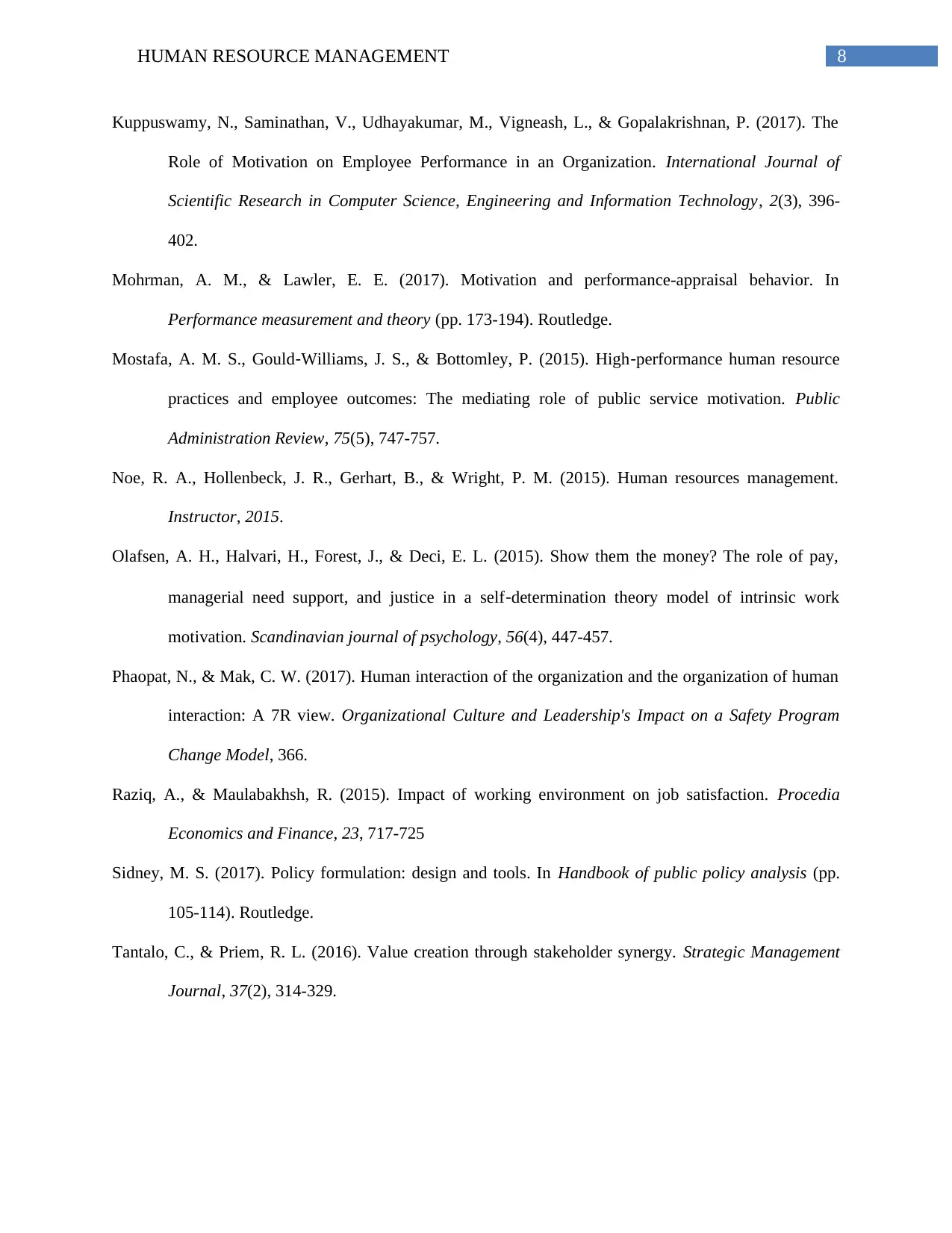
8HUMAN RESOURCE MANAGEMENT
Kuppuswamy, N., Saminathan, V., Udhayakumar, M., Vigneash, L., & Gopalakrishnan, P. (2017). The
Role of Motivation on Employee Performance in an Organization. International Journal of
Scientific Research in Computer Science, Engineering and Information Technology, 2(3), 396-
402.
Mohrman, A. M., & Lawler, E. E. (2017). Motivation and performance-appraisal behavior. In
Performance measurement and theory (pp. 173-194). Routledge.
Mostafa, A. M. S., Gould‐Williams, J. S., & Bottomley, P. (2015). High‐performance human resource
practices and employee outcomes: The mediating role of public service motivation. Public
Administration Review, 75(5), 747-757.
Noe, R. A., Hollenbeck, J. R., Gerhart, B., & Wright, P. M. (2015). Human resources management.
Instructor, 2015.
Olafsen, A. H., Halvari, H., Forest, J., & Deci, E. L. (2015). Show them the money? The role of pay,
managerial need support, and justice in a self‐determination theory model of intrinsic work
motivation. Scandinavian journal of psychology, 56(4), 447-457.
Phaopat, N., & Mak, C. W. (2017). Human interaction of the organization and the organization of human
interaction: A 7R view. Organizational Culture and Leadership's Impact on a Safety Program
Change Model, 366.
Raziq, A., & Maulabakhsh, R. (2015). Impact of working environment on job satisfaction. Procedia
Economics and Finance, 23, 717-725
Sidney, M. S. (2017). Policy formulation: design and tools. In Handbook of public policy analysis (pp.
105-114). Routledge.
Tantalo, C., & Priem, R. L. (2016). Value creation through stakeholder synergy. Strategic Management
Journal, 37(2), 314-329.
Kuppuswamy, N., Saminathan, V., Udhayakumar, M., Vigneash, L., & Gopalakrishnan, P. (2017). The
Role of Motivation on Employee Performance in an Organization. International Journal of
Scientific Research in Computer Science, Engineering and Information Technology, 2(3), 396-
402.
Mohrman, A. M., & Lawler, E. E. (2017). Motivation and performance-appraisal behavior. In
Performance measurement and theory (pp. 173-194). Routledge.
Mostafa, A. M. S., Gould‐Williams, J. S., & Bottomley, P. (2015). High‐performance human resource
practices and employee outcomes: The mediating role of public service motivation. Public
Administration Review, 75(5), 747-757.
Noe, R. A., Hollenbeck, J. R., Gerhart, B., & Wright, P. M. (2015). Human resources management.
Instructor, 2015.
Olafsen, A. H., Halvari, H., Forest, J., & Deci, E. L. (2015). Show them the money? The role of pay,
managerial need support, and justice in a self‐determination theory model of intrinsic work
motivation. Scandinavian journal of psychology, 56(4), 447-457.
Phaopat, N., & Mak, C. W. (2017). Human interaction of the organization and the organization of human
interaction: A 7R view. Organizational Culture and Leadership's Impact on a Safety Program
Change Model, 366.
Raziq, A., & Maulabakhsh, R. (2015). Impact of working environment on job satisfaction. Procedia
Economics and Finance, 23, 717-725
Sidney, M. S. (2017). Policy formulation: design and tools. In Handbook of public policy analysis (pp.
105-114). Routledge.
Tantalo, C., & Priem, R. L. (2016). Value creation through stakeholder synergy. Strategic Management
Journal, 37(2), 314-329.
⊘ This is a preview!⊘
Do you want full access?
Subscribe today to unlock all pages.

Trusted by 1+ million students worldwide
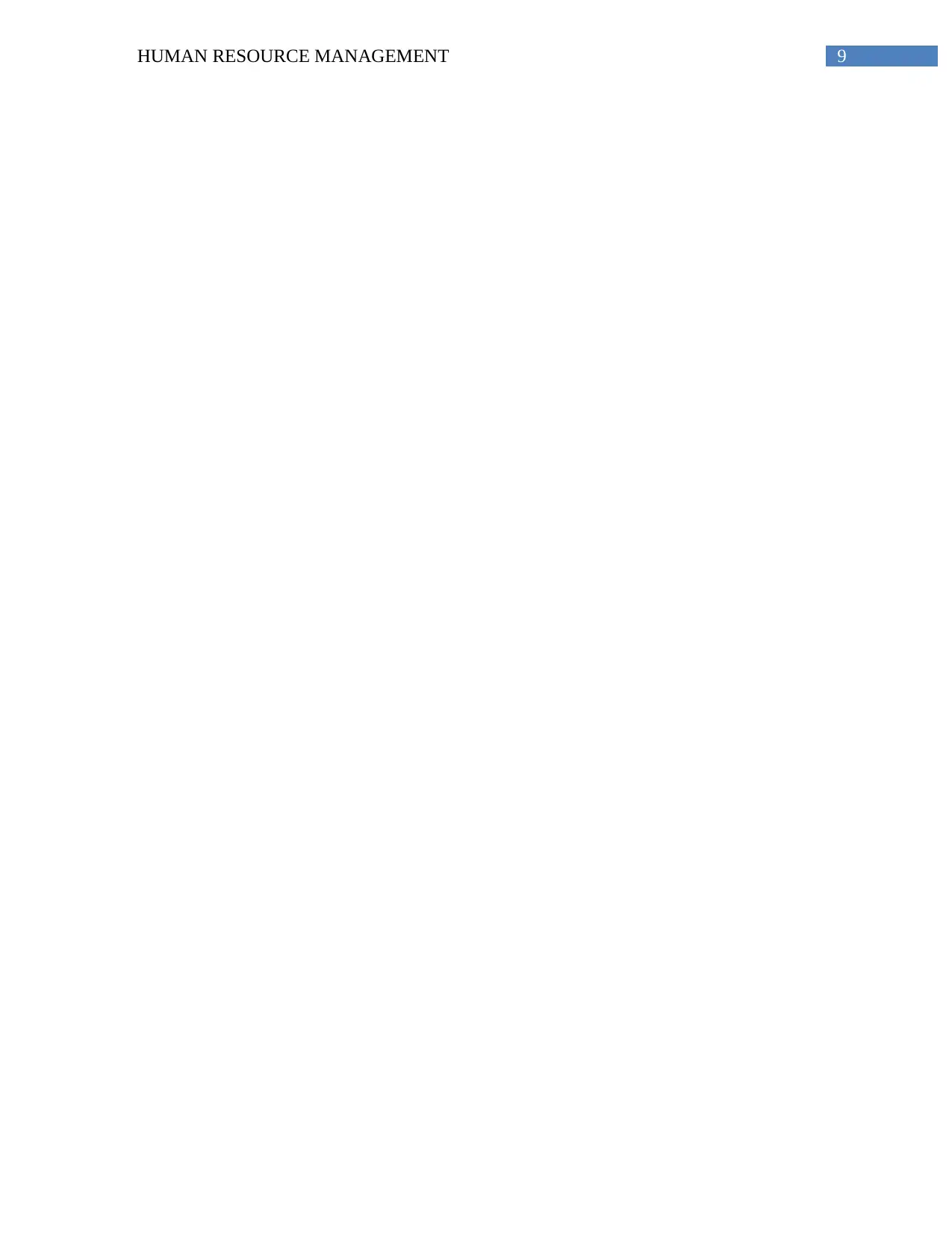
9HUMAN RESOURCE MANAGEMENT
1 out of 10
Related Documents
Your All-in-One AI-Powered Toolkit for Academic Success.
+13062052269
info@desklib.com
Available 24*7 on WhatsApp / Email
![[object Object]](/_next/static/media/star-bottom.7253800d.svg)
Unlock your academic potential
Copyright © 2020–2025 A2Z Services. All Rights Reserved. Developed and managed by ZUCOL.



